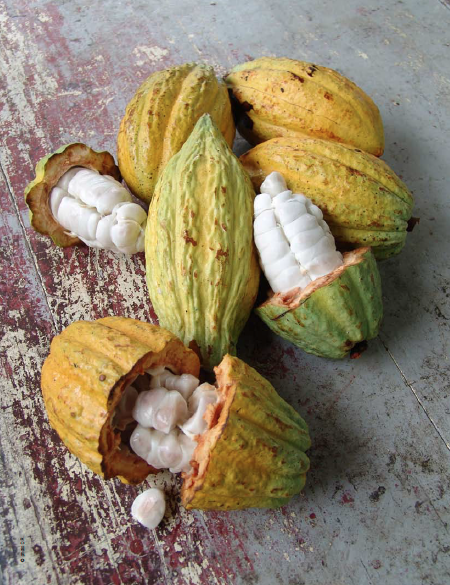ONCE UPON A TIME ...
All articles… Chocolate
An odyssey into the world of the grand crus
Trinidad, Madagascar, Indonesia, San Tome and Principle, Venezuela, Brazil, Cuba…45 countries throughout the world produce cocoa, and geography certainly plays a part in the enjoyment of chocolate. The cacao tree has lost none of its exoticism!
While the famous square continues to inspire food-lovers, we now tend to look upon it with more affectionate curiosity. The notion of a grand cru, for a long while a privilege accorded exclusively to wine, is now associated with chocolate. Just as a 1959 Conti from the Romanée-Conti estate has us daydreaming, so does a Chuao chocolate bar from Venezuela…
Because behind the word “cru” lies the notion of growth, linked to a terroir or region. Fascination with origins has replaced obsessions over cocoa content, conjuring up images of trunks with emerging cocoa pods, shaded by banana trees…

All that is cocoa is not dark though!
The most delicate chocolates come from the criollo, beautiful pods with colours reminiscent of the setting sun. On the inside, dainty white beans. The trinitario – so called because they come from Trinidad – are hybrid varieties. The African forastero, with its crimson beans, is used to make the most common kind of chocolate, but also the Nacional, a cocoa with superb notes of orange flower and jasmine.
Criollo, trinitario or forastero would be nothing without terroir or know-how, hence the success of the grand crus of the dark chocolate world, where taste takes pride of place. In 2003, dark chocolate surpassed the milk variety in popularity in France. A change in mentality occurred: more than just a raw material, the palate is alert to the specific flavours and prepares itself for the sensations to come… A hedonistic penchant that can be found elsewhere: the tea-lover who prefers rare Xishuangbanna teas to perfumed teas, the pepper-lover who speaks of Sarawak, Sichuan or Tasmanian pepper, or the saffron-lover who collects saffron from Quercy or Mund. As for chocolate lovers, they fantasise about beans from the mythical valleys: Cepe, Chuao and Choroni, or the Porcelana from Venezuela. They adore bars from Madagascar for their redcurrant, raspberry and blackcurrant notes, from Java for their woody notes, from Papua New Guinea for their smoky notes, as well as the Caribbean for their balsamic tones… These enthusiasts speak the multi-faceted language of chocolate
Ingrid Astier
BRIEFLY
Laurent Le Daniel has just been named a Chevalier dans l’Ordre National du Mérite. Congratulations to him for this prestigious award, which rewards a passionate pastry chef very invested in the sustainability of his profession.
Prepare Valentine’s Day! Take the time to discover the chocolate or fruity sweets offered by our chefs for sale online. By ordering this week you will be delivered on time.
The French team is selected for the Pastry World Cup! She won the European Cup ahead of Italy and the United Kingdom who are also selected for the grand final in January at Sirha.
JOBS
Pâtisserie
La maison Zanin recrute pour son laboratoire de Sallanches un Second pâtissier en CDI – 39h. Toutes les informations ici !
Pâtisserie
La maison Ducobu, en Belgique, recrute sur différents postes. Toutes les informations ici.





